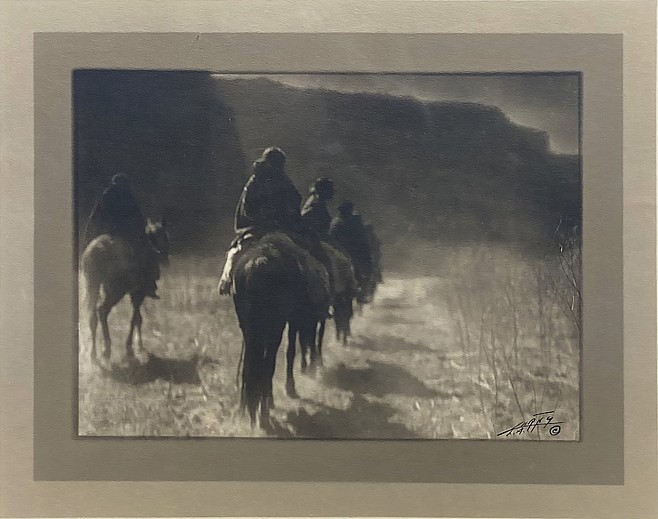
Breathtaking acquisition by iconic American photographer
July 7, 2023
Edward Curtis
American, 1868 - 1952
Celebrated American photographer and ethnologist, Edward Sheriff Curtis devoted his practice to the documentation of early 20th century Native American life and culture.
As government regulations, settlements, and industry encroached further upon tribal lands, indigenous people and their traditions became increasingly marginalized. For many, their way of life was threatened, and in some instances, had vanished entirely.
For over 30 years, Curtis photographed and documented more than 80 tribes - from west of the Mississippi to the Mexican border to northern Alaska. He not only recognized the pressing need to record and preserve indigenous culture, but to disseminate that knowledge across America.

In 1930, Curtis published The North American Indian, a massive photo-compendium, consisting of 20 folios. Each contains 75 hand-pressed photogravures, approximately 300 pages of text, and additional, supplemental photogravures.
Through his photography and the release of his film documentary, Curtis was able to raise awareness of the impending cultural destruction. His projects garnered support from prominent and powerful figures including President Theodore Roosevelt and J. Pierpont Morgan.
Interest in Curtis's work continues to grow. When the original The North American Indian entered the market in 2012, it broke records. Totaling over $1.4 million dollars, the sale was one of the all-time highest for photobooks.
The Vanishing Race, 1904
Curtis wrote that this scene of Navajo riding off into the distance showed “that the Indians as a race, already shorn in their tribal strength and stripped of their primitive dress, are passing into the darkness of an unknown future.”
Edward Curtis (American, 1868 - 1952)
Platinum Border Print
10 x 12 inches
Signed Lower Right

Edward Curtis
American, 1868 - 1952
Born in 1868 near Whitewater, Wisconsin, Edward Sheriff Curtis became one of America’s finest photographers and ethnologists. When the Curtis family moved to Port Orchard, Washington in 1887, Edward’s gift for photography led him to an investigation of the Indians living on the Seattle waterfront. His portrait of Chief Seattle’s daughter, Princess Angeline, won Curtis the highest award in a photographic contest. Having become well-known for his work-with the Indians, Curtis participated in the 1899 Harriman expedition to Alaska as one of two official photographers. He then accompanied George Bird Grinell, editor of Forest and Stream, on a trip to northern Montana. There they witnessed the deeply sacred Sundance of the Piegan and Blackfoot tribes. Travelling on horseback, with their pack horses trailing behind, they emerged from the mountains to view the valley floor massed with over a thousand teepees – an awesome sight to Curtis and one that transformed his life.
Everything fell into place at that moment: it was clear to him that he was to record, with pen and camera, the life of the North American Indian. Edward S. Curtis devoted the next 30 years photographing and documenting over eighty,tribes west of the Mississippi, from the Mexican border to northern Alaska. His project won support from such prominent and powerful figures as President Theodore Roosevelt and J. Pierpont Morgan. From 1911-1914, Curtis also produced and directed a silent film based on the mythology of the Rawakiutl Indians of the Pacific Northwest. Upon its completion in 1930, the work, entitled The North American Indian, consisted of 20 volumes, each containing 75 hand-pressed photogravures and approximagely 300 pages of text. Each volume was accompanied by a corresponding portfolio containing at least 36 photogravures.

Back to News


